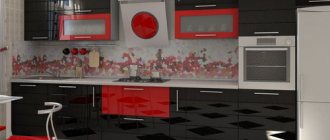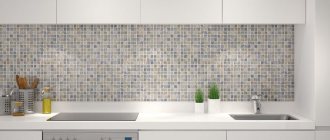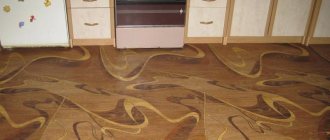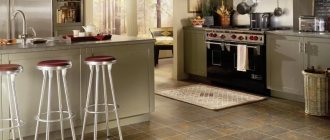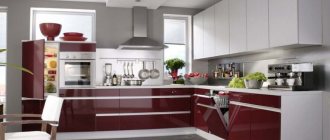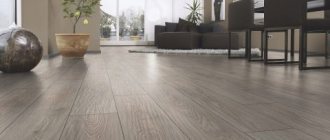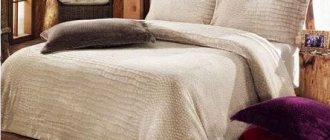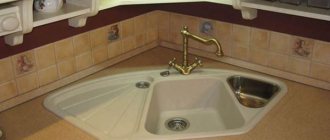Home/Articles/Linoleum for the kitchen: secrets of selection, purchase and installation (33 photos)
Thanks to the optimal price-quality ratio, linoleum occupies a leading position among the variety of floor coverings. Although there was a period of time when this flooring was considered outdated and inferior to other types of flooring, it has recently begun to regain its popularity.
What are the main points you should pay attention to when choosing linoleum for the kitchen?
Linoleum is an environmentally friendly flooring made from natural materials. This wear-resistant coating has a very long service life. Linoleum is resilient and has antibacterial properties, making it a particularly good choice for kitchens.
Four selection criteria will help you learn better about the features of linoleum
Material. Linoleum is made from natural materials including linseed oil, resin, wood flour and pigments.
Since these materials are of natural origin, they are also biodegradable, which is considered a definite advantage when choosing an environmentally friendly coating.
In addition, flaxseed oil is a powerful antiseptic. Thanks to this property, linoleum will protect the floor from harmful bacteria throughout its entire service.
Thickness. The kitchen floor has a purpose rather than a decorative purpose. The appropriate kitchen covering must withstand heavy loads without deforming, remain wear-resistant, and maintain an impeccable appearance.
The thickness of linoleum determines its wear resistance. Especially for kitchens there is linoleum with a thickness of 4-5 mm. This high-performance coating will withstand any intense load.
Coating. Unlike vinyl flooring, the pigments in linoleum run throughout the entire thickness of the material. Any scratches or heavy wear will be the same color as the surface, minimizing visual impact.
Slip. An important feature of linoleum is that, due to its coating, it usually has a rough surface. Therefore, linoleum is popular in places with high humidity.
The fact that this flooring is so easy to clean adds a lot of benefits, but the benefits don't end there.
Natural linoleum
The safest from an environmental point of view. It contains natural oils and resins, wood flour, minerals, and natural dyes. There are two types: with a base made of linen, jute or hemp fabric and without it.
Advantages:
Recommendations from the designer
Apron for the kitchen - 115 photos of modern ideas. Review of the best apron ideas with an exclusive design + instructions and video
- Plasterboard ceiling in the kitchen: design ideas, application features and current ceiling structures (100 photos)
Kitchen design 10 sq. m. - real photos of the application of stylish solutions and an overview of the most beautiful combinations in design
- high wear resistance;
- non-flammability;
- lack of ability to accumulate static electricity;
- resistance to high temperatures;
- the ability to retain the original color for a long time;
- resistance to aggressive environments;
- excellent compatibility with underfloor heating systems;
- no unpleasant odor.
Flaws:
- high price;
- inability to use in unheated rooms;
- risk of mold and rot.
Which is better – parquet or linoleum?
Linoleum, compared to hardwood flooring, is a less expensive way to achieve a more expensive look for a kitchen floor. One of the remarkable advantages of linoleum is that this material can look like wood, stone or any other floor, which cannot be said about parquet.
Linoleum has a number of useful qualities:
- Elasticity. Linoleum is an elastic flooring material. This means that soft and elastic linoleum provides a more comfortable experience in the kitchen, especially in places where you will have to stand a lot.
- Strength. The characteristics of linoleum make it a durable material. A well-maintained linoleum floor will save money in the long run, outlasting hardwood flooring.
- Moisture resistance. The surface of linoleum has water-repellent properties, therefore, the formation of mold and fungi is excluded. This makes linoleum a good choice for high-moisture areas such as the kitchen.
- Fire properties. Linoleum is not easily burned or melted by dropping hot or burning objects on it.
- Antistatic properties. Thanks to this property, linoleum is easier to clean, since dust will not stick to the floor surface due to static electricity.
- Unpretentiousness. Small cuts and gouges can be repaired using a spare piece of linoleum.
- Environmentally friendly. As stated earlier, linoleum flooring is gentle on the environment and its components are natural.
- Low cost. Compared to parquet, linoleum is much cheaper.
- Easy to install. Laying parquet flooring will require a lot of time, patience and additional leveling of the floor. Linoleum with a thickness of 3 mm does not require preparatory work or special skills.
And finally, parquet cannot boast of such a wide selection of colors, patterns, ornaments and styles, suitable for various designs, for which linoleum is famous.
Linoleum has many positive qualities, but it also has disadvantages:
- Temporary odor. New linoleum has a pronounced odor due to the content of linseed oil. Over time, the smell will disappear.
- Fading and yellowing. With frequent exposure to direct sunlight, the surface of linoleum quickly fades, and in dark places it turns yellow. This is a temporary discoloration that disappears within a few hours of exposure to sunlight.
Advice! A thin linoleum sheet requires a good, level base, otherwise any defects or imperfections will be “transmitted” through its surface.
Preparing the kitchen floor for linoleum
Linoleum for the kitchen: which linoleum to choose, selection rules and installation features
The kitchen floor prepared for laying linoleum must be smooth and hard. Experts note: the thinner the linoleum, the smoother the base surface should be, otherwise the coating will wear out much faster.
If possible, remove the old coating. Remove protruding irregularities and fill cracks and gouges with resin or putty. The ideal option is to level the floor with a special leveling compound. After it is completely dry, the surface is sanded well.
Before laying linoleum, it is recommended to vacuum the prepared base
It is very important - the floor under the linoleum must be dry so that the coating does not swell and an unpleasant musty smell does not appear in the kitchen.
Ideally, linoleum should be laid directly on the base. But in some cases, installation is possible on an old coating - for example, linoleum or ceramic tiles.
What color of linoleum to choose
Linoleum is available in a wide variety of colors and patterns. Even if the desired pattern is not available, the cut pieces can be used to create creative floor designs with stripes and patterns to end up with a unique style.
All this variety of colors and structures allows linoleum to imitate other materials. For example, you can make a kitchen floor that looks like wood or marble when it's actually linoleum.
Such a variety of textures allows you to finish the kitchen floor in any style:
- Plain material is suitable for high-tech, minimalism, techno or modern style.
- Imitation wood will look great in a Provence, vintage, country, eco or any ethnic style interior.
- Linoleum with the texture of ceramic tiles will appeal to those who decide to create a retro, classic or avant-garde style.
- Geometric and abstract designs are suitable for kitchens in the style of pop art, contemporary or futurism.
This material can accept and maintain very deep, rich colors, providing a wide variety of attractive visual effects.
In some cases, you can purchase linoleum that has intricate patterns and motifs on the surface of the material. However, these intricate designs often require installation experience.
The choice of linoleum color is influenced by the following factors:
- A small kitchen will look more spacious if the covering is made in cool colors, imitates small tiles or wooden flooring laid diagonally.
- The color of the linoleum should match the color of the set.
- For a bright kitchen, you should choose a neutral color covering, and for kitchens with a restrained palette, brightly colored linoleum is suitable.
- You can zone a large kitchen using a well-chosen range of linoleum shades in one color spectrum.
- Warm shades will fill the kitchen with coziness, and a monotonous repeating pattern will have a calming effect.
For a low cost, the buyer gets a chic look with minimal maintenance.
Photo of linoleum for the kitchen
Read here! Bar counter for the kitchen - the best options in modern interiors, tips on arrangement and photo examples in the review!
Please repost
1+
Preparatory work before installation
Most suppliers offer to install linoleum sheets, but recognize that buyers can do everything themselves.
The surface on which you want to lay linoleum must be smooth, clean, dry, without any impacts, dirt, oil or paint.
When installing, it is recommended to add a deck underlayment. You can use either a cork lining, which helps reduce noise, or plastic, which provides excellent moisture protection.
To lay linoleum you will need the following tools:
- well-sharpened knives for cutting fabric;
- serrated steel spatula (150-200 mm);
- wooden spatula;
- long ruler;
- chalk;
- double-sided tape, mastic or glue;
- optionally – liquid for welding seams.
Linoleum sheets can be installed over an existing floor as long as it is securely attached to the subfloor. If this is not the case, then you need to get rid of it. If plank flooring is installed in the kitchen, then before installing linoleum, the boards are covered with plywood and screwed with self-tapping screws.
Advice! While working on preparing the floor, you should definitely lay out the linoleum somewhere nearby for a couple of days so that the canvas acclimatizes to room temperature. In an insufficiently warmed state, the linoleum sheet is too fragile.
Installation work
Laying linoleum does not require special skills. Everything is quite simple. Before laying the canvas, it is important to ensure that the surface is in perfect condition.
There should not be any irregularities here. Defects may appear after some time.
Therefore, before installation, work is carried out to level the surface of the floor in the kitchen.
Laying linoleum
Laying linoleum is easier and faster than preparing to work with it. There are three methods for installing canvases:
- No glue required.
- Using glue.
- Pasting with mastic.
The first method is the simplest: apply double-sided tape around the perimeter of the sheet and another one at the base. After laying, you need to go over the surface with a wooden spatula to expel the air.
The second method is the most durable: to lay linoleum using glue, you need to bend the sheet to the middle, then apply the glue using a spatula. Before applying the canvas to the floor, you need to hold it in the air, and after laying, squeeze out the air using a smooth spatula. The gluing process is repeated with the second half of the coating.
The third method is too expensive, so it is rarely used at home, more often in commercial enterprises.
Color variations of linoleum
Linoleum can be made in deep, rich colors, which will undoubtedly decorate the kitchen space. For the interior of the kitchen, like any other room, it is important to choose the right shade of the floor to create a holistic image. So, its choice is made taking into account the following nuances:
- For a small kitchen space, the best option would be a cold-colored floor covering that imitates wood flooring or tiles.
- The color of linoleum is selected so as to harmoniously match the shade of the kitchen set.
- For a bright kitchen interior, a neutral color of flooring material is suitable and vice versa.
- When zoning the kitchen, you can use the option that is performed using linoleum of different tones.
- For greater comfort in the kitchen interior, experts advise using warm tones of linoleum.
- Transverse and diagonal patterns expand the space, while longitudinal ones lengthen them.
- A floor covering with a small repeating pattern at a certain step has a calming effect.
- Brightness and contrast are suitable for brave individuals who always want to get a boost of energy from the interior of their kitchen.
Important! On floor coverings that are too light or dark, any dirt and crumbs are clearly visible, so grayish or brown tones will be the optimal color scheme for the kitchen.
White linoleum
An ultra-modern trend is laying white linoleum in the kitchen space. This interior immediately attracts attention with its unusualness and style. To many, this solution seems impractical, and this is true if cleaning is not carried out regularly. White linoleum must be of high quality only, so that the material does not become unusable during active use and constant wet cleaning.
Important! White linoleum will significantly expand the kitchen space and fill it with light.
Light coating
Light-colored linoleum is best used in the interior of a kitchen with low lighting, a small area located on the north side, where little sunlight reaches.
Light-colored flooring material in the kitchen interior may or may not have an ornament. Thus, a monochromatic textured option looks fashionable and elegant and, due to its interesting design, can be chosen for various interior styles.
Dark linoleum
As previously mentioned, a dark color for kitchen flooring is very appropriate, since all dirt and surface defects will be visible on it. But some styles involve the use of such linoleum, and many apartment owners want to see exactly this design.
Linoleum in black or wenge looks fashionable, especially when contrasted with walls and furniture. These are original solutions that will become the basis for creating a unique interior design that will attract attention.
Important! For a small room, you should not buy a dark version of linoleum, since this kind of solution can hide square meters.
How much does it cost and where can I buy it?
The cost of linoleum depends on several factors:
- manufacturer country;
- brand name;
- flooring type.
Russian manufacturers offer the simplest linoleum at a cost of 120 rubles per sq. m. m., while the price for foreign goods starts from 300 rubles.
Domestic household linoleum costs from 120 rubles, and foreign from 220 rubles. This type of flooring is designed for light loads. As you know, a low price does not determine the best quality of the material.
Semi-commercial linoleum is much more reliable in quality, which is why it is so valued among buyers. Its price is approximately 300 rubles per sq. m. m.
The next variety is commercial linoleum. A meter of this type of flooring costs from 850 rubles, but it consists of several layers, withstanding a significant load.
Finally, the most expensive material is linoleum made from natural fabrics. The price for this type of flooring is higher than the previous ones - from 1000 rubles.
You can buy linoleum in large construction stores or order from online suppliers.
Why is linoleum worse/better than tiles and laminate?
There are a number of reasons explaining why it is necessary to put linoleum on the floor in the kitchen, and not tiles or laminate. Among the main advantages of the material:
- Durability (linoleum of classes 32 and 33 have a service life of 8 to 15 years);
- High wear resistance - can withstand falls from sharp and heavy objects, suitable for apartments with pets;
- Easy to care for – PVC coating is very easy to clean. In addition, unlike laminate and parquet boards, it is easily washed off from spilled beet juice or red wine;
- It has heat and sound insulation properties, it is much warmer than laminate and tiles, in addition, this material can be called the quietest;
- Wide range of designs - PVC coating can perfectly imitate a wooden floor in both color and relief texture. Today, high-quality linoleum cannot be immediately distinguished from parquet boards or laminate. But wooden textures are not the only possible design, because there are flooring options for tiles, leather or stone. The most popular colors and textures can be seen below in the photo of linoleum in the kitchen interior;
- Cost - depending on the manufacturer, type and wear resistance class, the price varies from 150 to 800 rubles. for 1 sq. m;
In a kitchen, a material costing at least 350 rubles per sq.m. is acceptable.
- Linoleum can be laid easily, quickly and as cleanly as possible with your own hands, unlike any other floor coverings;
- Also, you can entrust the installation to specialists relatively inexpensively - professional laying of tiles, laminate, parquet boards and pouring self-leveling floors costs much more, and laying them yourself is more difficult and troublesome;
- Dismantling a linoleum floor is very simple; you can also do it yourself, without a partner or special tools.
And now about the disadvantages:
- Heavy furniture can cause dents;
- Artificiality of the material - natural materials are always more valuable and beautiful;
- If linoleum is purchased at temperatures below +10°C, then you cannot unroll the roll immediately after purchase. You need to let it rest (folded) at room temperature (not lower than +15 C) for 1-2 days. Otherwise, it may crack;
- If you lay it incorrectly and not on a leveled base, then it can “float” and this will wear out faster;
- When joining several pieces of linoleum, the seam will be visible, but if you join the pattern correctly, the joint will not be so noticeable.
Top brands
There are several linoleum manufacturers that offer their products through a network of retailers and distributors:
- Forbo (UK);
- ARMSTRONG (UK);
- TARKETT (Germany);
- Sinteros (Russia);
- IVC (Belgium);
- SOMMER (France).
Their products can also be found in several online stores.
When it comes to purchasing high-quality flooring for the kitchen, the deciding factor in this matter, of course, will be durability, environmental friendliness, a large collection of colors and the price of the material. Linoleum fully corresponds to these qualities.
What types of linoleum for apartments are there?
There are many varieties that differ in certain characteristics, positive or negative qualities.
Types
There is a main classification:
- Commercial. It is quite dense, resistant to abrasion and can withstand heavy loads perfectly.
- Semi-commercial. It features an even thicker protective layer and high wear resistance. The semi-commercial type has a felt and synthetic base that helps retain heat.
- Domestic. It is considered the most inexpensive option, perfectly withstanding minor loads.
Types of linoleum coating differ in thickness, protective layer, susceptibility to abrasion, materials used for manufacturing and nature of application.
Material
Popular types of materials:
- Natural. It has a jute base; resin from deciduous trees, wood flour, lime as a filler, and natural coloring pigments are used to give color.
- PVC. It may have a fabric or non-woven base, one layer or several. This polyvinyl chloride coating is cold, as it has low thermal conductivity, but at the same time is highly environmentally friendly and resistant to fungus. Based on its composition, it is divided into homogeneous and heterogeneous. Often, for PVC linoleum, a cork backing is used as an additional layer.
- Rubber. Relin has a front layer made of rubber with filler and pigment and a lining, the base of which is made of crushed rubber and bitumen.
- Alkyd. Glyphthalic or alkyd linoleum is distinguished by a fabric base with an alkyd resin applied to it. It consists of oils, fillers, pigments and sometimes an antiseptic.
The type of material completely affects not only the performance characteristics of the finish, but also the warmth and comfort of the lined surface.
Surface varieties
Several types:
- Smooth. Enhances interior aesthetics significantly and provides an ideal backdrop.
- Embossed. Due to the velvety and rough texture, the relief surface reflects less light and is perceived much softer and more comfortable.
- Matte. It perfectly scatters the light falling on it, allows you to hide small defects and irregularities and is a very elegant design option for any room.
- Glossy. It has a prestigious appearance and good reflective properties, which makes the room look much lighter.
Due to a certain type of surface, you can endow the space with even more interest and character.
Linoleum in the kitchen real photos
Types of linoleum
Depending on the scope of application and the level of required traffic (that is, the load that the material can withstand), linoleum is divided into three types: household, semi-commercial, commercial.
Domestic
Typically used in residential areas and where there is low load. The thickness of the product is usually 1.2 – 1.6 mm. The advantage of household linoleum is its low price. The disadvantage is a rather low level of strength, although with proper use it can maintain an attractive appearance for quite a long time, more than 5-7 years.
Chess pattern on household linoleum in the living room
Semi-commercial
Used in rooms with average traffic levels, offices, shops, etc. Made from PVC and fiberglass, which makes it more durable than household linoleum. The material has good heat and sound insulation characteristics.
Semi-commercial linoleum in the office with a pattern imitating tiles
Linoleum under tiles can be coated with a special compound, which makes it more wear-resistant. The cost of this type of linoleum can be approximately the same as that of household linoleum, it all depends on the manufacturer.
Commercial
It is considered the most wear-resistant and expensive, and is resistant to chemicals. It is used in places with high traffic levels, for example, in shopping centers.
Bright autumn color of the flooring in a small cafe
Commercial linoleum comes in two types:
- Artificial (synthetic materials are used for production);
- Natural (flax oil, wood flour, natural fibers are used for production). This is a more durable and environmentally friendly type - it can operate for 30-40 years.
Black and white checkered linoleum goes well with red shades
School corridor with colored checkered flooring
Which is better, linoleum or tile?
Each has its own pros and cons.
Linoleum is larger than tile, which means it is more difficult to repair. Here the tiles won. However, thanks to this, linoleum is easier to lay; there is no need to lay many parts of the floor covering; everything is covered in one or several pieces.
Linoleum is produced with a large number of patterns; linoleum for the kitchen is produced under tiles, diamonds or other patterns. Tiles also have this option.
The resistance to all types of influences of linoleum and tiles is approximately the same; the only thing is that tiles can crack if heavy objects fall, and linoleum can wrinkle.
There is one universal option, floor tiles made from linoleum, but this option will be more expensive than regular linoleum. Such tiles take longer to lay, but are easier to partially replace and repair.
Types of linoleum by purpose
In Russia, linoleum manufacturers, when releasing products to the market, carry out technical tests and confirm compliance with GOST 7251-77 - according to this standard, the material is divided into three types, based on the purpose of use:
- Domestic. It has a thickness of 3 mm, designed for use at home for 8 years;
- Commercial. It has increased strength due to the protective layer (7mm) and lasts up to 30 years. Suitable for use at industrial facilities, municipal and educational institutions.
- Semi-commercial. Combines the advantages of the above types - with a thickness of 5 mm, it lasts up to 12 years with proper care and is affordable.
Buying the second type of coating for home use is unprofitable; it is better to give preference to the first and third options.
